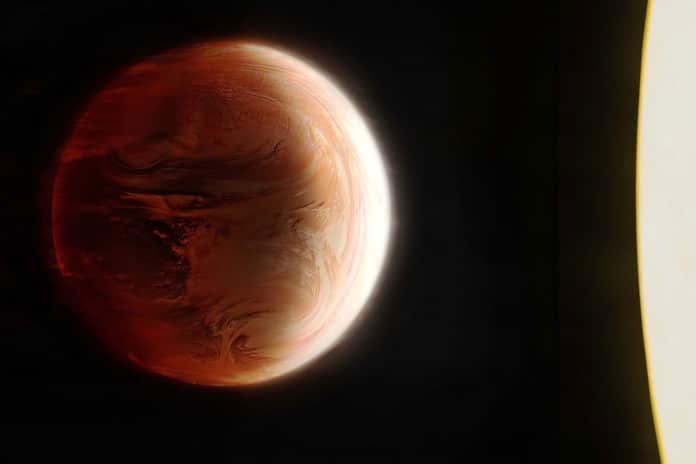Using Hubble Space Telescope, an International team obtained the clearest view on the dark side of a hot Jupiter that lies 855 light-years from Earth. The hot Jupiter exoplanet called WASP-121 b is tidally locked to its star, resulting in a cold hemisphere and a hot hemisphere.
The team also gets insights into the unusual atmospheric conditions of an exoplanet by merging the data from the dayside and nightside hemispheres. Their analysis shows a detailed view of an exoplanet’s global atmosphere.
Astronomers also made the first detailed measurements of an alien water cycle for the first time. They examined the evaporation of airborne metals and minerals on the hot dayside and metal clouds and liquid ruby and sapphire rain on the cooler night side.
WASP-121b is a massive gas giant nearly twice the size of Jupiter. It is an ultrahot Jupiter with one of the shortest orbits detected to date. It takes 30 hours to orbit its star. As mentioned above, the planet is tidally locked to its star in such a way that its star-facing dayside is permanently roasting, while its nightside is turned forever toward space.
The clouds on WASP-121 b consist of iron, magnesium, chromium, and vanadium.
Dr. Hannah Wakeford of the University of Bristol’s School of Physics said: “The water cycle on Earth is trapped close to the ground constantly changing from liquid to gas to solid. However, the new Hubble data reveals a water cycle on WASP-121b high in the atmosphere that is completely alien to us on Earth.”
The temperature in the upper atmosphere can rise by 3000 degrees Celsius. It causes the water to glow and many molecules to break down into their atomic components. On the other hand, the temperature drops by approximately 1500 degrees Celsius on the nightside hemisphere.
The extreme temperature difference between the two hemispheres prompts strong winds to sweep around the entire planet from west to east, dragging the disrupted water molecules along. Eventually, they reach the nightside. The lower temperatures allow the hydrogen and oxygen atoms to recombine, forming water vapor again before being blown back around to the dayside where the cycle repeats. Temperatures never drop low enough for water clouds to develop throughout the cycle, let alone rain.
The data from Hubble indicates that temperatures drop low enough for the metals to condense into clouds on the nightside, which are blown around to the dayside, where they evaporate.
The team did not detect Aluminium and titanium in an exoplanet’s atmosphere. They are thought to have condensed and rained down into deeper layers of the atmosphere, not accessible to observations. This rain would be unlike any known in the Solar System.
Dr. Hannah Wakeford of the University of Bristol’s School of Physics said, “We have seen indications of these types of clouds forming in other planetary atmospheres, but these data show that there may be processes deeper in the planets trapping clouds that are beyond our reach. This will have implications for the total energy of the planet and how it transports material around.”
Lead author Thomas Mikal-Evans from the Max Planck Institute for Astronomy (MPIA) in Heidelberg said: “Despite the discovery of thousands of exoplanets, we’ve only been able to study the atmospheres of a small fraction due to the challenging nature of the observations. So far, most of these measurements have provided limited information, such as basic details on the chemical composition or average temperature in specific subregions of the atmosphere.”
Co-author David Sing from the Johns Hopkins University in Baltimore, USA, explained: “To probe the entire surface of WASP-121 b, we took spectra with Hubble during two complete planet revolutions.”
Dr. Wakeford added: “The Hubble Space Telescope is in low Earth orbit going around the Earth once every 90 minutes. For this program, we designed it so that we would point at the same target for 26 Hubble orbits in a row, that is a very challenging set-up, but it has given us amazing insight into WASP-121 b’s atmosphere.”
Journal Reference:
- Mikal-Evans, T., Sing, D.K., Barstow, J.K. et al. Diurnal variations in the stratosphere of the ultrahot giant exoplanet WASP-121b. Nat Astron (2022). DOI: 10.1038/s41550-021-01592-w
